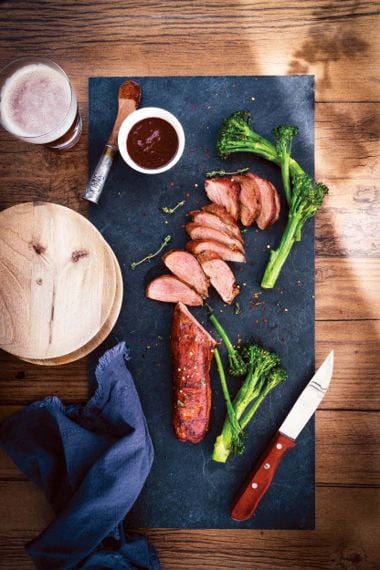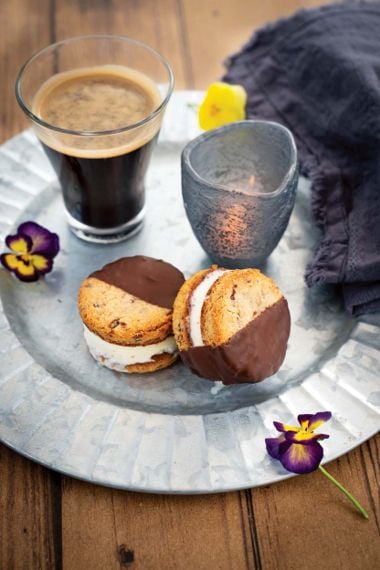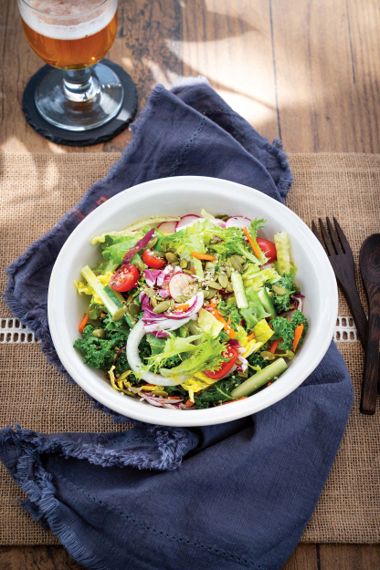Fire It up on Father’s Day
This month, we’re celebrating all the special dads, dad figures, and dad mentors out there with a collection of delicious recipes for Father’s Day. We’ve jazzed up the BBQ with some gutsy flavours coupled with options to satisfy the vegetarian and vegan in the crowd. Plus, we’ve provided a few hints for pairing the best-flavoured suds with your meal.
Every dish in our Dad’s Day menu is perfect for serving either outdoors or in, depending on the weather. Make it extra special by gifting your “dad” with a new apron and some BBQ tools. Then be sure to line up family members as sous chefs and give your dad the attention and help he deserves.
Whether they’re flipping burgers or tempeh patties, grilling up planked fish, or assembling a massive salad—a little help on the sidelines will score high on the gratitude scale. For extra points, roll up your sleeves and offer to do all the cleanup.

Typical of Vietnamese fare, bánh mi is a familiar Saigon submarine-type sandwich often sold by street vendors. It’s a soft bun loaded with pickled veggies and shaved cucumber piled high onto grilled meat. We jazzed up our version with spicy kimchi and plenty of fresh crisp cucumber to balance it out.

Cedar-plank grilling is an exceptional way to cook fish without fear of overcooking. Hints of wood smoke penetrate the flesh to add depth while retaining moisture. Cod is commonly available already smoked in many stores, but it can often taste oversalted and dry. Our version suggests using fresh cod from Iceland; grilling on soaked cedar provides smoky overtones while keeping it moist and tasty. Delicious with a new-potato salad and grilled veggies.

Coffee-flavoured BBQ sauce? Why not? It’s a strikingly flavourful combo—sweet, tangy, bold, and rich. It can be used not only on pork but on a variety of other meats. We marinated tenderloin in it and doubled up on the smoky flavour by grilling it on a cedar plank. Serve with a side order of grilled broccolini for extra yum.

Ice cream cakes and/or cookies are everyone’s favourite. And here’s a great option for a delicious “Dad’s” cookie cake that’s gluten free! A simple-to-make cookie cake that’s made even easier when the dough is tossed together in a food processor. End a delicious Dad’s Day meal with this deliciously cool and creamy sweet dessert.
Quaffable beer tips
These days beer comes in a dizzying selection of flavours, in an equally diverse array of cans and bottles that bear labels with amazingly creative artwork. From large producers to microbreweries, there’s a flavoured beer to appeal to almost anyone.
For our recipes, we’ve provided our best recommendations based on the recipes, although there’s never just one truly perfect match. Here’s a layperson’s guide to flavours in a widely diverse selection. Let your own beer bias prevail!
IPA stands for India pale ale and is understood to be one of the first brews of the “craft” beer movement. There are many flavours in the IPA grouping, ranging from citrus high notes to hoppy and bitter overtones. Given the immense variety, a flight of IPAs covering a citrus note, hoppy tone, and herbal flavour would be the best way to cover all ranges of taste buds.
Lager is mild and easy to quaff for the beginner in the crowd. It’s a great bevvy for any grilled or chilled recipe. A honey-flavoured lager is an especially easy sipper. Pilsners fall into this grouping.
Pale ale, not to be confused with India pale ale, is blonde in colour and has light alcohol content with a hit of malt.
Stout is a dark and heavier brew stemming from unfermented sugars. Typically sweet overtones, roasted, and somewhat creamy on the tongue. Some brews come with hints of espresso and dark chocolate.
Porter is much like stout but with a greater suggestion of chocolate overtones.
Belgian beers cover the gamut from light to dark and hoppy to citrusy with an enhanced alcohol content.
Wheat beer, like the grain, is light in colour and in alcohol content—perfect for a summer day.
Sour beer is, as it’s called, “sour” as well as tart—perfect for someone with super discerning taste buds.







